Literature Review: Polish Immigrants' Integration in American Society
VerifiedAdded on 2022/09/16
|6
|1166
|21
Literature Review
AI Summary
This literature review examines the experiences of Polish immigrants in America, drawing on four key articles. The review explores the formation of Polonia, the challenges of integration and acculturation, and the conflicts between different generations of Polish immigrants and the Polish ethnic groups. It discusses the role of cultural expressions, such as music and education, in shaping Polish-American identity. The review also highlights the educational experiences of Polish immigrants in Chicago and the efforts to address their needs. The studies analyzed offer insights into the social, cultural, and political dimensions of Polish immigration and its impact on American society, providing a comprehensive overview of the complexities of Polish-American identity and integration.
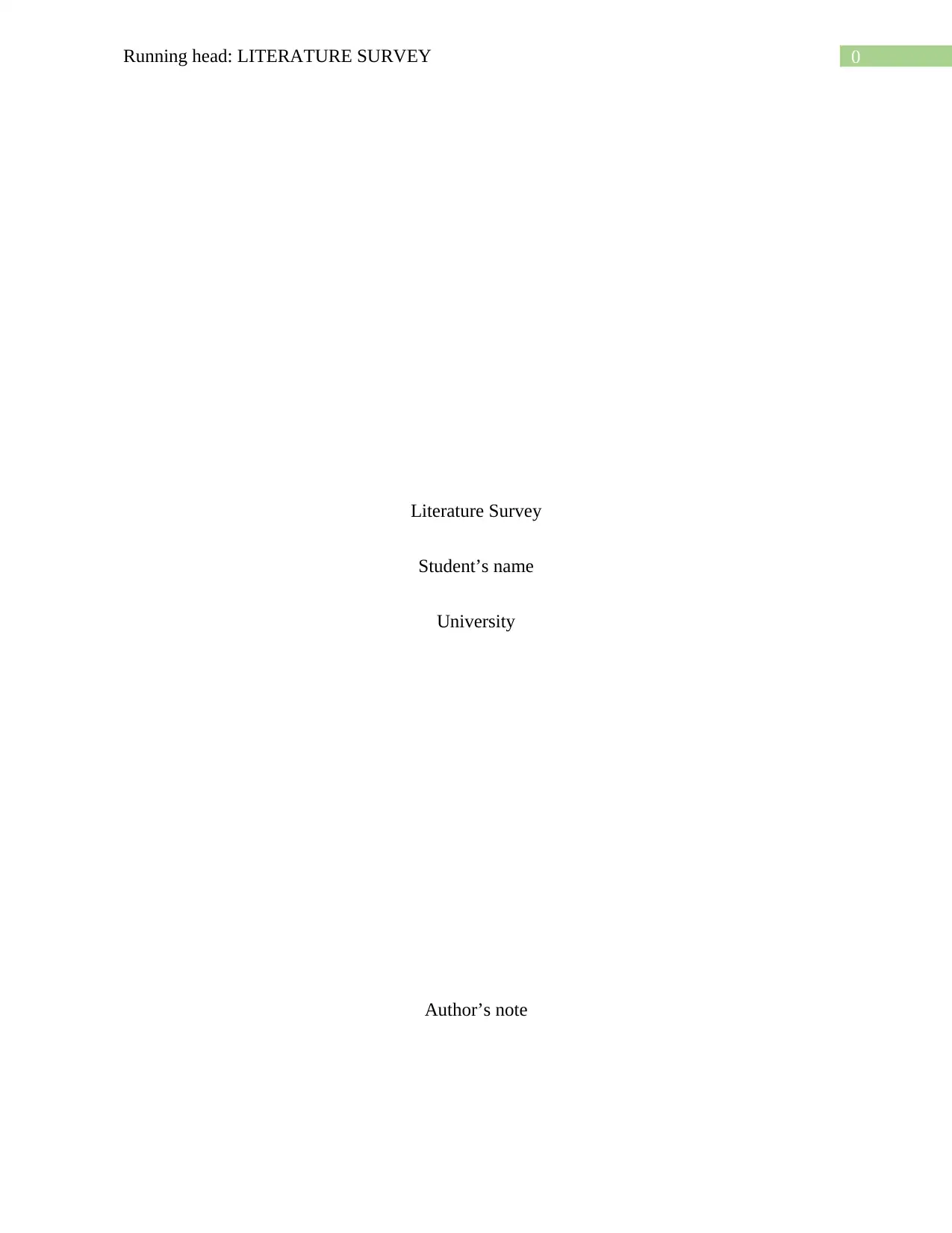
0Running head: LITERATURE SURVEY
Literature Survey
Student’s name
University
Author’s note
Literature Survey
Student’s name
University
Author’s note
Paraphrase This Document
Need a fresh take? Get an instant paraphrase of this document with our AI Paraphraser
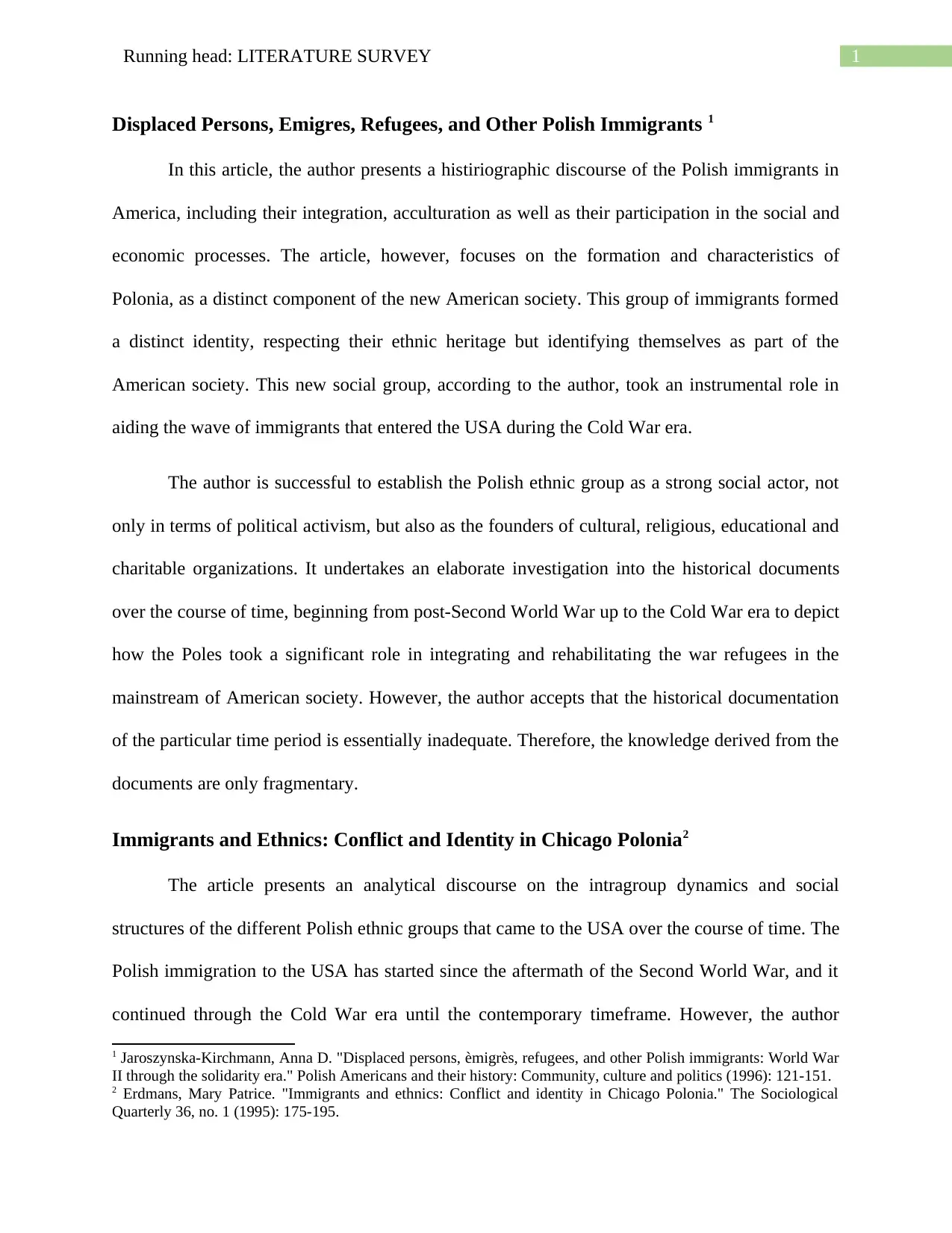
1Running head: LITERATURE SURVEY
Displaced Persons, Emigres, Refugees, and Other Polish Immigrants 1
In this article, the author presents a histiriographic discourse of the Polish immigrants in
America, including their integration, acculturation as well as their participation in the social and
economic processes. The article, however, focuses on the formation and characteristics of
Polonia, as a distinct component of the new American society. This group of immigrants formed
a distinct identity, respecting their ethnic heritage but identifying themselves as part of the
American society. This new social group, according to the author, took an instrumental role in
aiding the wave of immigrants that entered the USA during the Cold War era.
The author is successful to establish the Polish ethnic group as a strong social actor, not
only in terms of political activism, but also as the founders of cultural, religious, educational and
charitable organizations. It undertakes an elaborate investigation into the historical documents
over the course of time, beginning from post-Second World War up to the Cold War era to depict
how the Poles took a significant role in integrating and rehabilitating the war refugees in the
mainstream of American society. However, the author accepts that the historical documentation
of the particular time period is essentially inadequate. Therefore, the knowledge derived from the
documents are only fragmentary.
Immigrants and Ethnics: Conflict and Identity in Chicago Polonia2
The article presents an analytical discourse on the intragroup dynamics and social
structures of the different Polish ethnic groups that came to the USA over the course of time. The
Polish immigration to the USA has started since the aftermath of the Second World War, and it
continued through the Cold War era until the contemporary timeframe. However, the author
1 Jaroszynska-Kirchmann, Anna D. "Displaced persons, èmigrès, refugees, and other Polish immigrants: World War
II through the solidarity era." Polish Americans and their history: Community, culture and politics (1996): 121-151.
2 Erdmans, Mary Patrice. "Immigrants and ethnics: Conflict and identity in Chicago Polonia." The Sociological
Quarterly 36, no. 1 (1995): 175-195.
Displaced Persons, Emigres, Refugees, and Other Polish Immigrants 1
In this article, the author presents a histiriographic discourse of the Polish immigrants in
America, including their integration, acculturation as well as their participation in the social and
economic processes. The article, however, focuses on the formation and characteristics of
Polonia, as a distinct component of the new American society. This group of immigrants formed
a distinct identity, respecting their ethnic heritage but identifying themselves as part of the
American society. This new social group, according to the author, took an instrumental role in
aiding the wave of immigrants that entered the USA during the Cold War era.
The author is successful to establish the Polish ethnic group as a strong social actor, not
only in terms of political activism, but also as the founders of cultural, religious, educational and
charitable organizations. It undertakes an elaborate investigation into the historical documents
over the course of time, beginning from post-Second World War up to the Cold War era to depict
how the Poles took a significant role in integrating and rehabilitating the war refugees in the
mainstream of American society. However, the author accepts that the historical documentation
of the particular time period is essentially inadequate. Therefore, the knowledge derived from the
documents are only fragmentary.
Immigrants and Ethnics: Conflict and Identity in Chicago Polonia2
The article presents an analytical discourse on the intragroup dynamics and social
structures of the different Polish ethnic groups that came to the USA over the course of time. The
Polish immigration to the USA has started since the aftermath of the Second World War, and it
continued through the Cold War era until the contemporary timeframe. However, the author
1 Jaroszynska-Kirchmann, Anna D. "Displaced persons, èmigrès, refugees, and other Polish immigrants: World War
II through the solidarity era." Polish Americans and their history: Community, culture and politics (1996): 121-151.
2 Erdmans, Mary Patrice. "Immigrants and ethnics: Conflict and identity in Chicago Polonia." The Sociological
Quarterly 36, no. 1 (1995): 175-195.
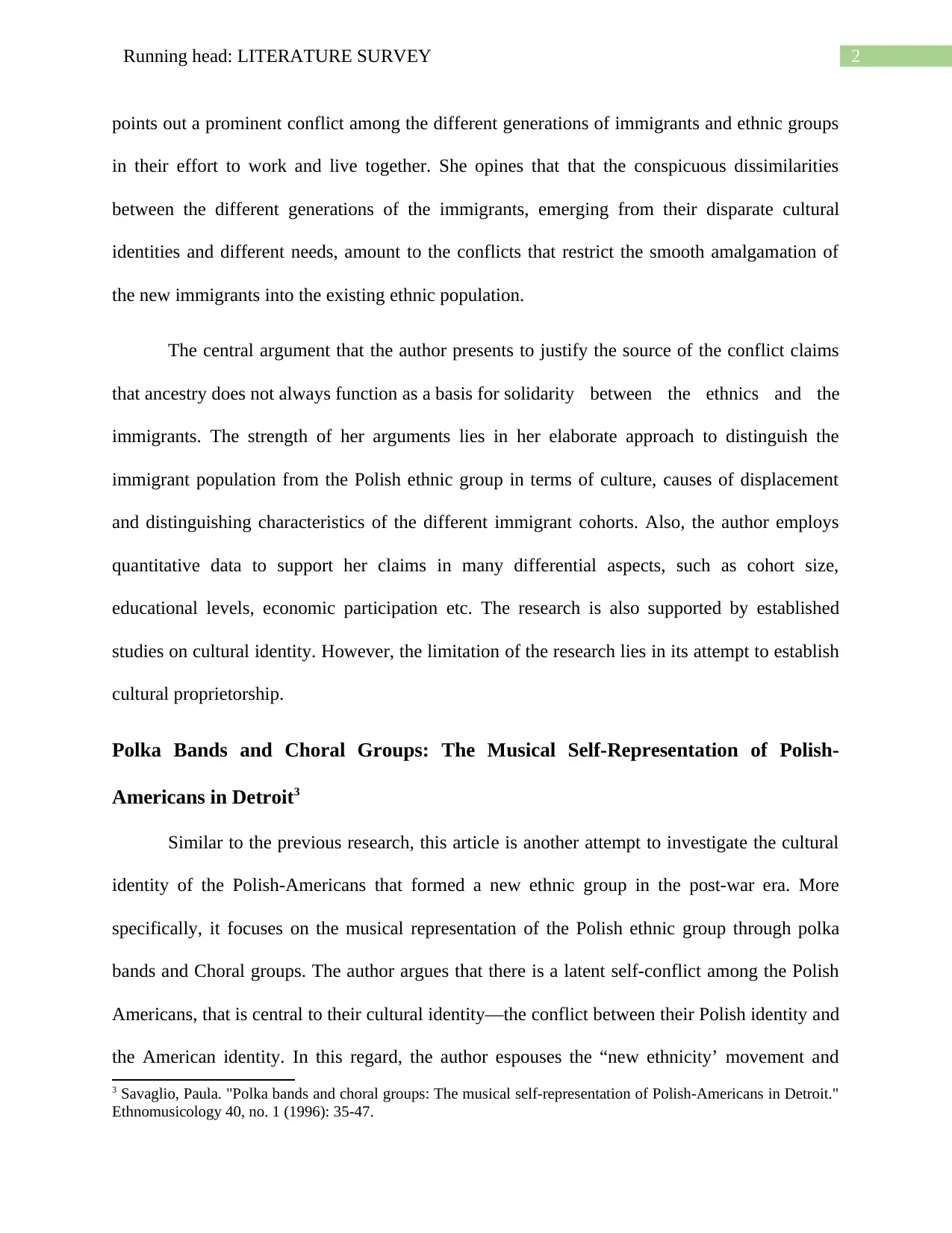
2Running head: LITERATURE SURVEY
points out a prominent conflict among the different generations of immigrants and ethnic groups
in their effort to work and live together. She opines that that the conspicuous dissimilarities
between the different generations of the immigrants, emerging from their disparate cultural
identities and different needs, amount to the conflicts that restrict the smooth amalgamation of
the new immigrants into the existing ethnic population.
The central argument that the author presents to justify the source of the conflict claims
that ancestry does not always function as a basis for solidarity between the ethnics and the
immigrants. The strength of her arguments lies in her elaborate approach to distinguish the
immigrant population from the Polish ethnic group in terms of culture, causes of displacement
and distinguishing characteristics of the different immigrant cohorts. Also, the author employs
quantitative data to support her claims in many differential aspects, such as cohort size,
educational levels, economic participation etc. The research is also supported by established
studies on cultural identity. However, the limitation of the research lies in its attempt to establish
cultural proprietorship.
Polka Bands and Choral Groups: The Musical Self-Representation of Polish-
Americans in Detroit3
Similar to the previous research, this article is another attempt to investigate the cultural
identity of the Polish-Americans that formed a new ethnic group in the post-war era. More
specifically, it focuses on the musical representation of the Polish ethnic group through polka
bands and Choral groups. The author argues that there is a latent self-conflict among the Polish
Americans, that is central to their cultural identity—the conflict between their Polish identity and
the American identity. In this regard, the author espouses the “new ethnicity’ movement and
3 Savaglio, Paula. "Polka bands and choral groups: The musical self-representation of Polish-Americans in Detroit."
Ethnomusicology 40, no. 1 (1996): 35-47.
points out a prominent conflict among the different generations of immigrants and ethnic groups
in their effort to work and live together. She opines that that the conspicuous dissimilarities
between the different generations of the immigrants, emerging from their disparate cultural
identities and different needs, amount to the conflicts that restrict the smooth amalgamation of
the new immigrants into the existing ethnic population.
The central argument that the author presents to justify the source of the conflict claims
that ancestry does not always function as a basis for solidarity between the ethnics and the
immigrants. The strength of her arguments lies in her elaborate approach to distinguish the
immigrant population from the Polish ethnic group in terms of culture, causes of displacement
and distinguishing characteristics of the different immigrant cohorts. Also, the author employs
quantitative data to support her claims in many differential aspects, such as cohort size,
educational levels, economic participation etc. The research is also supported by established
studies on cultural identity. However, the limitation of the research lies in its attempt to establish
cultural proprietorship.
Polka Bands and Choral Groups: The Musical Self-Representation of Polish-
Americans in Detroit3
Similar to the previous research, this article is another attempt to investigate the cultural
identity of the Polish-Americans that formed a new ethnic group in the post-war era. More
specifically, it focuses on the musical representation of the Polish ethnic group through polka
bands and Choral groups. The author argues that there is a latent self-conflict among the Polish
Americans, that is central to their cultural identity—the conflict between their Polish identity and
the American identity. In this regard, the author espouses the “new ethnicity’ movement and
3 Savaglio, Paula. "Polka bands and choral groups: The musical self-representation of Polish-Americans in Detroit."
Ethnomusicology 40, no. 1 (1996): 35-47.
⊘ This is a preview!⊘
Do you want full access?
Subscribe today to unlock all pages.

Trusted by 1+ million students worldwide
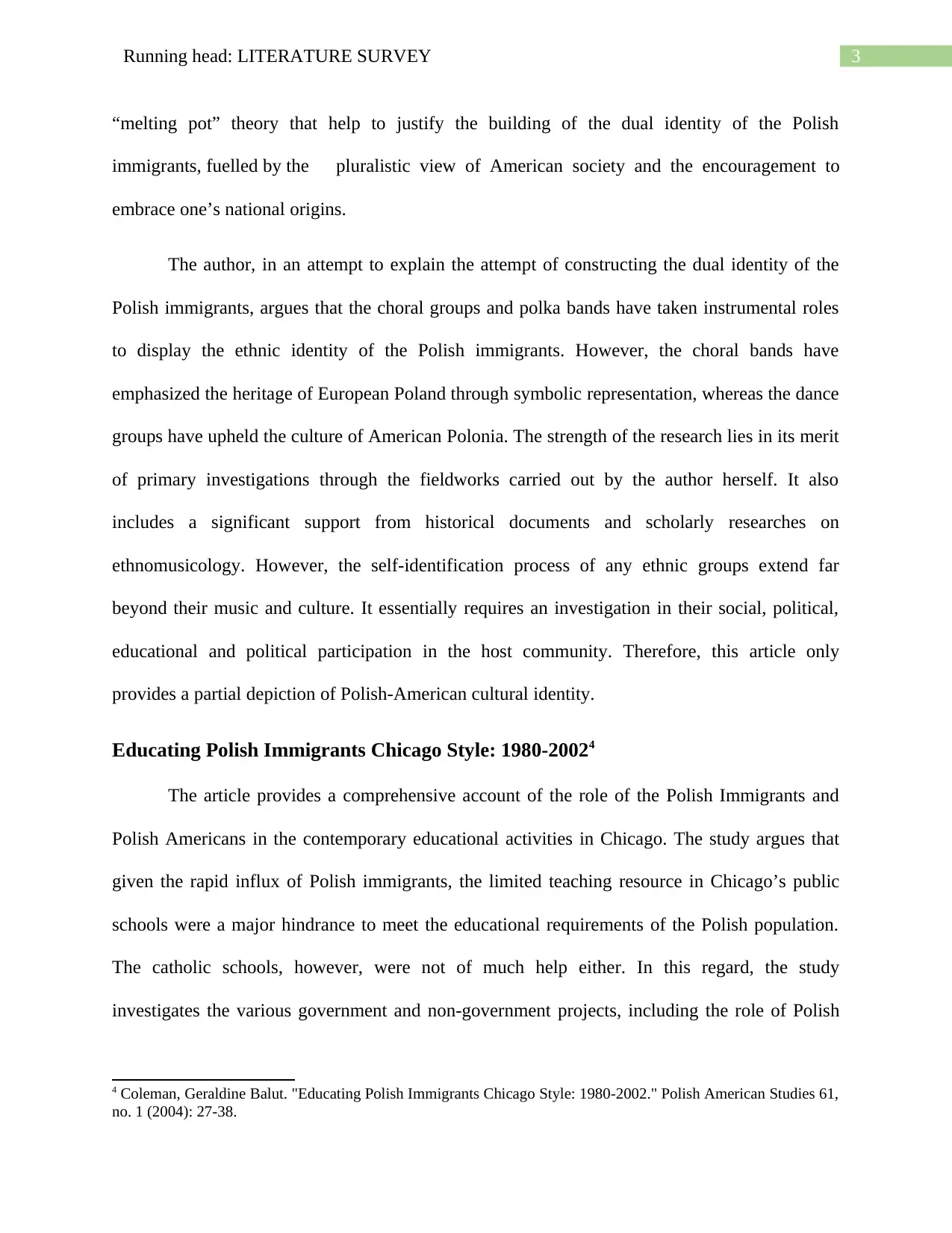
3Running head: LITERATURE SURVEY
“melting pot” theory that help to justify the building of the dual identity of the Polish
immigrants, fuelled by the pluralistic view of American society and the encouragement to
embrace one’s national origins.
The author, in an attempt to explain the attempt of constructing the dual identity of the
Polish immigrants, argues that the choral groups and polka bands have taken instrumental roles
to display the ethnic identity of the Polish immigrants. However, the choral bands have
emphasized the heritage of European Poland through symbolic representation, whereas the dance
groups have upheld the culture of American Polonia. The strength of the research lies in its merit
of primary investigations through the fieldworks carried out by the author herself. It also
includes a significant support from historical documents and scholarly researches on
ethnomusicology. However, the self-identification process of any ethnic groups extend far
beyond their music and culture. It essentially requires an investigation in their social, political,
educational and political participation in the host community. Therefore, this article only
provides a partial depiction of Polish-American cultural identity.
Educating Polish Immigrants Chicago Style: 1980-20024
The article provides a comprehensive account of the role of the Polish Immigrants and
Polish Americans in the contemporary educational activities in Chicago. The study argues that
given the rapid influx of Polish immigrants, the limited teaching resource in Chicago’s public
schools were a major hindrance to meet the educational requirements of the Polish population.
The catholic schools, however, were not of much help either. In this regard, the study
investigates the various government and non-government projects, including the role of Polish
4 Coleman, Geraldine Balut. "Educating Polish Immigrants Chicago Style: 1980-2002." Polish American Studies 61,
no. 1 (2004): 27-38.
“melting pot” theory that help to justify the building of the dual identity of the Polish
immigrants, fuelled by the pluralistic view of American society and the encouragement to
embrace one’s national origins.
The author, in an attempt to explain the attempt of constructing the dual identity of the
Polish immigrants, argues that the choral groups and polka bands have taken instrumental roles
to display the ethnic identity of the Polish immigrants. However, the choral bands have
emphasized the heritage of European Poland through symbolic representation, whereas the dance
groups have upheld the culture of American Polonia. The strength of the research lies in its merit
of primary investigations through the fieldworks carried out by the author herself. It also
includes a significant support from historical documents and scholarly researches on
ethnomusicology. However, the self-identification process of any ethnic groups extend far
beyond their music and culture. It essentially requires an investigation in their social, political,
educational and political participation in the host community. Therefore, this article only
provides a partial depiction of Polish-American cultural identity.
Educating Polish Immigrants Chicago Style: 1980-20024
The article provides a comprehensive account of the role of the Polish Immigrants and
Polish Americans in the contemporary educational activities in Chicago. The study argues that
given the rapid influx of Polish immigrants, the limited teaching resource in Chicago’s public
schools were a major hindrance to meet the educational requirements of the Polish population.
The catholic schools, however, were not of much help either. In this regard, the study
investigates the various government and non-government projects, including the role of Polish
4 Coleman, Geraldine Balut. "Educating Polish Immigrants Chicago Style: 1980-2002." Polish American Studies 61,
no. 1 (2004): 27-38.
Paraphrase This Document
Need a fresh take? Get an instant paraphrase of this document with our AI Paraphraser
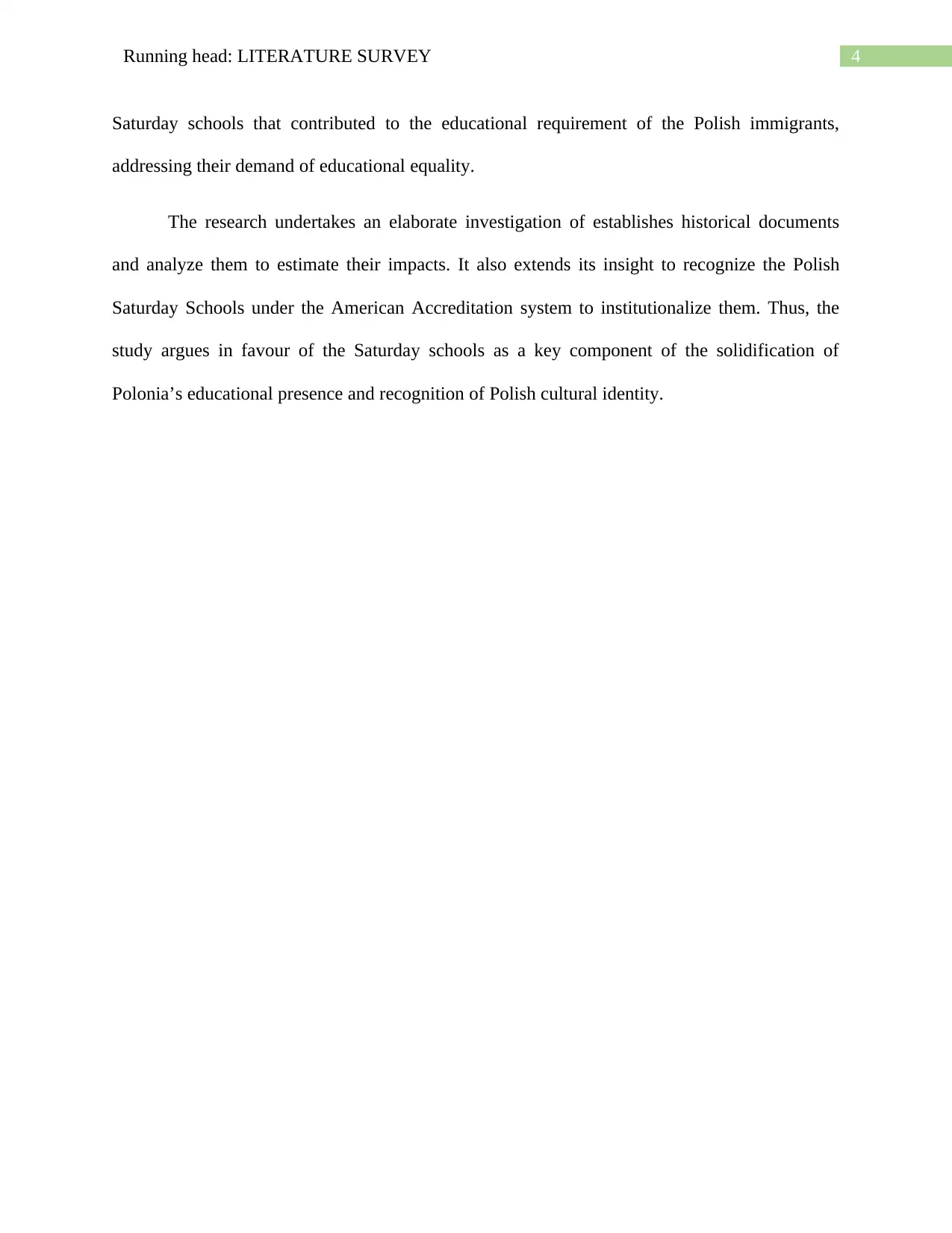
4Running head: LITERATURE SURVEY
Saturday schools that contributed to the educational requirement of the Polish immigrants,
addressing their demand of educational equality.
The research undertakes an elaborate investigation of establishes historical documents
and analyze them to estimate their impacts. It also extends its insight to recognize the Polish
Saturday Schools under the American Accreditation system to institutionalize them. Thus, the
study argues in favour of the Saturday schools as a key component of the solidification of
Polonia’s educational presence and recognition of Polish cultural identity.
Saturday schools that contributed to the educational requirement of the Polish immigrants,
addressing their demand of educational equality.
The research undertakes an elaborate investigation of establishes historical documents
and analyze them to estimate their impacts. It also extends its insight to recognize the Polish
Saturday Schools under the American Accreditation system to institutionalize them. Thus, the
study argues in favour of the Saturday schools as a key component of the solidification of
Polonia’s educational presence and recognition of Polish cultural identity.
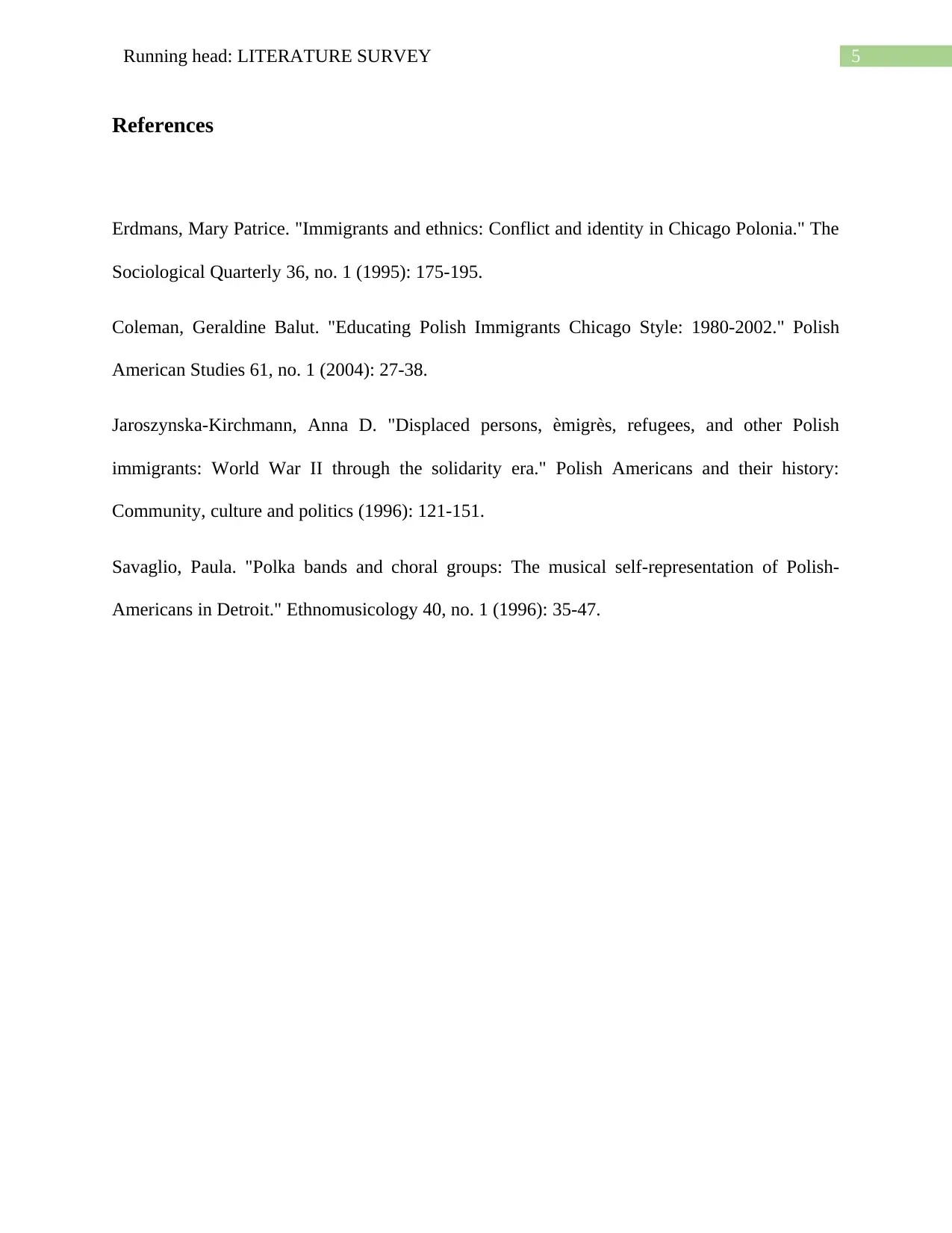
5Running head: LITERATURE SURVEY
References
Erdmans, Mary Patrice. "Immigrants and ethnics: Conflict and identity in Chicago Polonia." The
Sociological Quarterly 36, no. 1 (1995): 175-195.
Coleman, Geraldine Balut. "Educating Polish Immigrants Chicago Style: 1980-2002." Polish
American Studies 61, no. 1 (2004): 27-38.
Jaroszynska-Kirchmann, Anna D. "Displaced persons, èmigrès, refugees, and other Polish
immigrants: World War II through the solidarity era." Polish Americans and their history:
Community, culture and politics (1996): 121-151.
Savaglio, Paula. "Polka bands and choral groups: The musical self-representation of Polish-
Americans in Detroit." Ethnomusicology 40, no. 1 (1996): 35-47.
References
Erdmans, Mary Patrice. "Immigrants and ethnics: Conflict and identity in Chicago Polonia." The
Sociological Quarterly 36, no. 1 (1995): 175-195.
Coleman, Geraldine Balut. "Educating Polish Immigrants Chicago Style: 1980-2002." Polish
American Studies 61, no. 1 (2004): 27-38.
Jaroszynska-Kirchmann, Anna D. "Displaced persons, èmigrès, refugees, and other Polish
immigrants: World War II through the solidarity era." Polish Americans and their history:
Community, culture and politics (1996): 121-151.
Savaglio, Paula. "Polka bands and choral groups: The musical self-representation of Polish-
Americans in Detroit." Ethnomusicology 40, no. 1 (1996): 35-47.
⊘ This is a preview!⊘
Do you want full access?
Subscribe today to unlock all pages.

Trusted by 1+ million students worldwide
1 out of 6
Your All-in-One AI-Powered Toolkit for Academic Success.
+13062052269
info@desklib.com
Available 24*7 on WhatsApp / Email
![[object Object]](/_next/static/media/star-bottom.7253800d.svg)
Unlock your academic potential
Copyright © 2020–2025 A2Z Services. All Rights Reserved. Developed and managed by ZUCOL.

